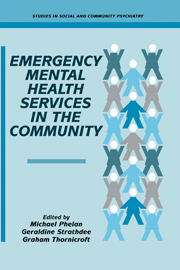Book contents
- Frontmatter
- Contents
- Contributors
- Foreword
- PRINCIPLES AND POLICIES
- 1 The scope and limitations of emergency mental health services in the community
- 2 Service models in emergency psychiatry: an international review
- 3 Users' perspective on emergency needs
- 4 Legal aspects of mental health emergencise
- 5 The economics of mental health emergency services
- 6 Suicide prevention
- 7 Using the crisis
- 8 Community assessment of crisis
- CHALLENGE OF IMPLEMENTATION
- Index
1 - The scope and limitations of emergency mental health services in the community
from PRINCIPLES AND POLICIES
Published online by Cambridge University Press: 28 October 2009
- Frontmatter
- Contents
- Contributors
- Foreword
- PRINCIPLES AND POLICIES
- 1 The scope and limitations of emergency mental health services in the community
- 2 Service models in emergency psychiatry: an international review
- 3 Users' perspective on emergency needs
- 4 Legal aspects of mental health emergencise
- 5 The economics of mental health emergency services
- 6 Suicide prevention
- 7 Using the crisis
- 8 Community assessment of crisis
- CHALLENGE OF IMPLEMENTATION
- Index
Summary
Introduction
When psychiatric care was based in large psychiatric hospitals there was a limited professional response to what would nowadays be called, a psychiatric emergency – i.e., disturbed patients who, posing a risk to themselves or to others, were taken to hospital and admitted. These hospitals were often many miles from where the patients lived, and as admissions were long-term, patients were isolated from their relatives and other social supports. Emergency care was passive and curative.
The advent of community psychiatry has changed this. In contrast to the traditional waiting attitude of the psychiatric hospital, community psychiatry is concerned with actively reaching out into the community and providing local and flexible services which meet the differing needs of those requiring help. The philosophy of community psychiatry is to be active and preventive, instead of passive and curative. However, to provide appropriate early intervention in emergency situations is clearly a difficult and complex task.
Isolated attempts to provide non-hospital based help to those in crisis are not new. For instance, in New York a telephone hotline had been established at the beginning of the twentieth century by Warren, an Anglican clergyman, in order to prevent suicides (Allen, 1984), and in Amsterdam during the 1930s a mobile psychiatric emergency service was set up with the aim of preventing hospitalisation and thus reduce the costs of care for the city (Querido, 1968).
- Type
- Chapter
- Information
- Emergency Mental Health Services in the Community , pp. 3 - 15Publisher: Cambridge University PressPrint publication year: 1995



